Sydney Town Hall
Hill & Son 1886-89, 5 manuals, 127 speaking stops, tubular-pneumatic/Barker lever
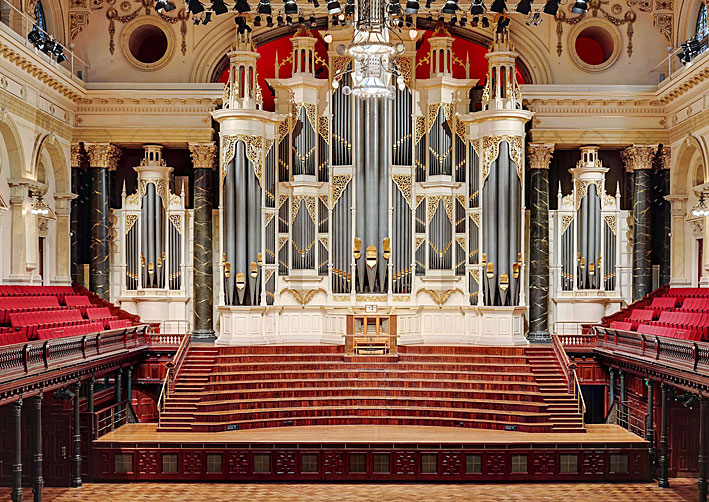
Photograph posted on Facebook (October 2013)
Please click here for a virtual tour of the Sydney Town Hall
Historical and Technical Documentation by Kelvin Hastie, © OHTA 2005, (last updated October 2005)
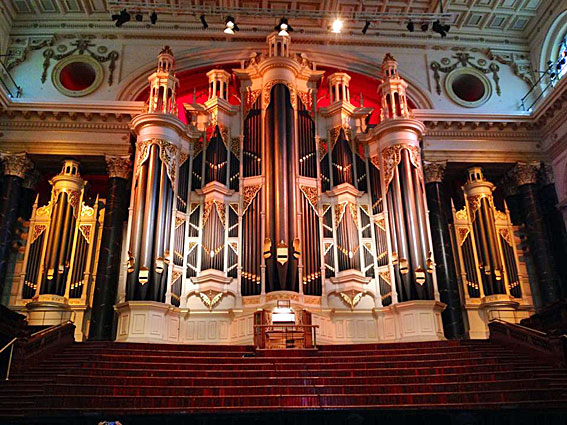
Upon completion, this was the grandest and most impressive civic complex in the British Empire and included the Centennial Hall, the largest of its kind. The hall incorporates a massive ceiling in moulded zinc manufactured by the Sydney firm of Wunderlich, stained glass windows depicting Australian flora and a floor of Tasmanian blackwood and tallowwood. The faux marble pillars were part of the original plans but only realised in the 1991 restoration. The Hill & Son grand organ is the focal point of the hall and located in a massive elliptical cove. [1]

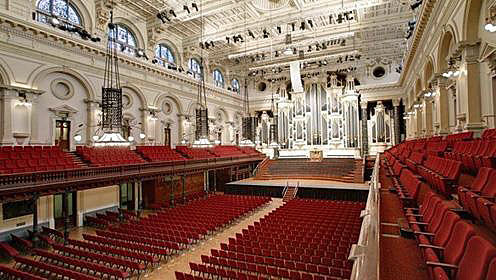
The history of the Town Hall organ has been very well documented and so will not be covered extensively here. [2] Built between 1886 and 1889 by Hill & Son, of London (and not provided with a job number), the instrument was instantly famous for then being the world’s largest organ and for the novelty of its full-length 64-foot Contra Trombone stop. It remains the world’s largest organ without any electric action components and is of international significance as representing the pinnacle of British achievement in the Victorian era, even though its conservative design was the subject of debate at the time. [3] It is easily the best-known of all Australian organs and is the source of admiration around the world, not only for the immensity and opulence of its tone and for its magnificent case, but also for its high level of originality and the quality of the restoration work.

Although the organ is considered substantially original in condition, several changes have been made over the years. The most significant of these was the lowering of the pitch to concert standard by S.T. Noad in 1939, this change being most noticeable in the reed stops, which are coarser in tone colour as a result. A comprehensive restoration was undertaken over ten years from 1972 by Roger H. Pogson Pty Ltd and many of the minor changes (such as the swapping of ranks between Swell and Choir) were reversed. Other changes retained to the present are the balanced swell pedals (the provision of which necessitated the removal of four composition pedals for the Great), the concave/radiating pedalboard, the transposition of Swell Piccolo from 2’ to 1’, the addition of the high-pitched Carillon bells to the Solo, the enclosure of the Solo orchestral reeds and the enclosure of the entire Choir division (originally only the reeds were enclosed). [4] During the work carried out by Roger Pogson some alterations were made to the pneumatic action operating the Choir division and the console timbers (originally in fumed oak) were lightened during repolishing.
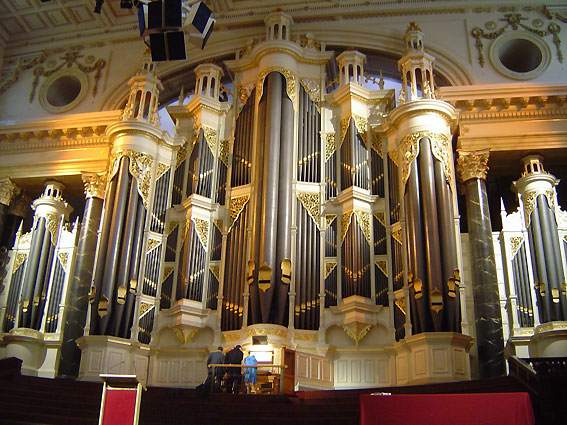
Click here for more pictures
Live recordings can be downloaded as an mp3 file by clicking on the links below.
"Prelude (3.2MB), Fugue (5.7MB) and Postlude" (5.6MB), "Prelude in C" (3MB) by Bruckner, played by Mark Quarmby in 1996
Demonstration of the 64' Contra Trombone played by Michael Dudman, recorded in 1982 for an ABC radio broadcast
Video demonstration of bottom C of the 64' Contra Trombone (videoed by Michael Murray)
Click here for a schedule of this year's Town Hall Organ recitals
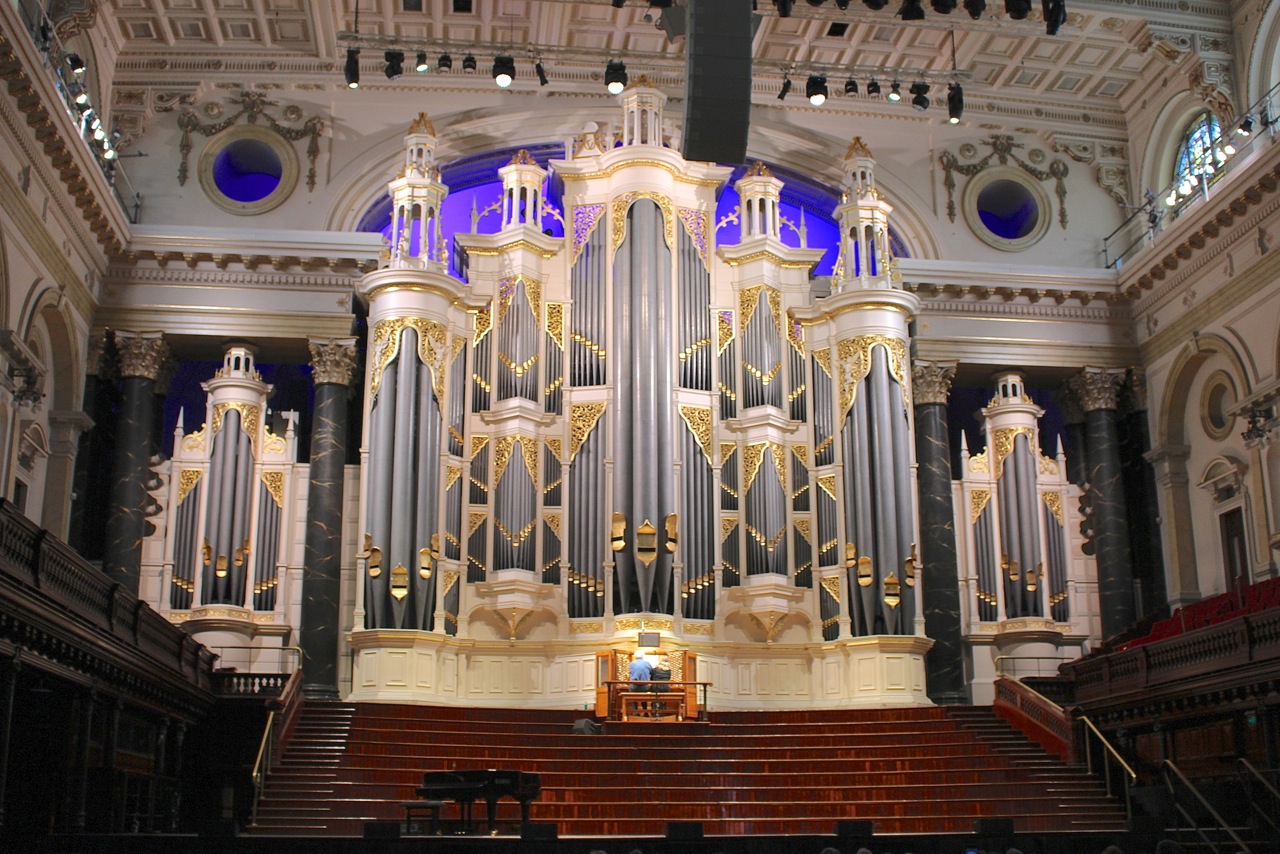
Photo: Trevor Bunning (taken during the lunchtime duet recital on 2 October 2018)
Robert Ampt [Sydney City Organist] and Amy Johansen [Univertisty of Sydney Organist] performing
Hill & Son 1886-89 (5/127 tubular-pneumatic/Barker lever)
| GREAT Contra Bourdon Double Open Diapason Bourdon Open Diapason I Open Diapason II Open Diapason III Open Diapason IV Harmonic Flute Viola Spitz Flöte Gamba Hohl Flöte Rohr Flöte Quint Principal Octave Gemshorn Harmonic Flute Twelfth Fifteenth Mixture Cymbel Sharp Mixture Furniture Contra Posaune Posaune Trumpet Clarion SWELL Double Open Diapason Bourdon Open Diapason Hohl Flöte Viola da Gamba Salicional Dulciana Vox Angelica Octave Rohr Flöte Harmonic Flute Gemshorn Twelfth Fifteenth Piccolo Mixture Furniture Trombone Bassoon Trumpet Cornopean Horn Oboe Clarion CHOIR (enclosed) Contra Dulciana Open Diapason Hohl Flöte Lieblich Gedackt Flauto Traverso Gamba Dulciana Octave Violino Celestina Lieblich Flöte Twelfth Fifteenth Dulcet Dulciana Mixture Bassoon Oboe Clarinet Vox Humana Octave Oboe SOLO (small reeds enclosed) Bourdon Open Diapason Violin Diapason Doppel Flöte Flauto Traverso Stopped Diapason Viola Octave Harmonic Flute Flauto Traverso Harmonic Piccolo Contra Fagotto Harmonic Trumpet Corno di Bassetto Orchestral Oboe Cor Anglais Octave Oboe Contra Tuba Tuba Tuba Clarion Carillon Bells ECHO (enclosed and non-expressive) Lieblich Gedackt Viol d'Amour Unda Maris II Viol d'Amour Flageolet Glockenspiel Echo Dul. Cornet Basset Horn PEDAL Double Open Diapason Metal Double Open Diapason Wood Contra Bourdon Open Diapason Metal Open Diapason Wood Bourdon Violone Gamba Dulciana Quint Octave Prestant Bass Flute Violoncello Twelfth Fifteenth Mixture Mixture Mixture Contra Trombone Contra Posaune Posaune Trombone Bassoon Trumpet Clarion |
32 16 16 8 8 8 8 8 8 8 8 8 8 6 4 4 4 4 3 2 3 Rks 4 Rks 4 Rks 5 Rks 16 8 8 4 16 16 8 8 8 8 8 8 4 4 4 4 3 2 1 4 Rks 5 Rks 16 16 8 8 8 8 4 16 8 8 8 8 8 8 4 4 4 4 3 2 2 3 Rks 16 8 8 8 4 16 8 8 8 8 8 8 4 4 4 2 16 8 8 8 8 4 16 8 4 2 8 8 8 4 2 4 Rks 4 Rks 8 32 32 32 16 16 16 16 16 16 12 8 8 8 8 6 4 4 Rks 3 Rks 2 Rks 64 32 16 16 16 8 4 |
TC + + ^ ^ + + + ^ ^ * ¶ ^ ~ |
COUPLERS
Great to Pedal
Swell to Pedal
Choir to Pedal
Solo to Pedal
Swell to Great #
Swell Super Octave [to Great] #
Swell Sub Octave [to Great] #
Solo to Great #
Solo Octave
Choir to Great #
Swell to Choir
Solo to Choir
Echo to Swell
Pedal to Great Pistons
Tremulant to Swell (toe lever)
Tremulant to Choir and Solo (toe lever)
Tubular pneumatic key, stop and
combination action (vacuum for stops).
Mechanical action with pneumatic-lever
assistance for Great and couplers
marked #
Compass 61/30
Pistons (internally adjustable):
3 to Echo
7 to Solo
8 to Swell
8 to Great
7 to Choir
6 to Pedal (toe levers)
Balanced swell pedals for Choir, Solo
orchestral reeds and Swell
No. of pipes = 8,756
Pitch a1 = 440Hz
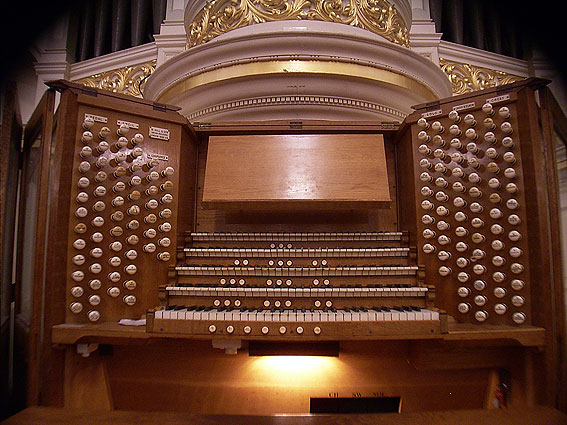
Wind pressures:
Great:
Flues 90mm (3 ½”)
Reeds 128mm (5”)
Swell:
Flues 90 mm (3 ½”)
Reeds 128 mm (5”)
Choir:
Flues & Reeds 70mm (2 ¾”)
Solo:
Flues 78mm (3”)
Orchestral reeds 128 mm (5”)
Tubas 256mm (10”)
Echo:
Flues and reeds 58mm (2 ¼”)
Pedal:
Flues 82mm (3 ¼”)
Reeds 115 mm (4 ½”)
+ On 128mm (5”) wind
* Originally at 2’ pitch
¶ On 90mm (3 ½”) wind
§ Metal bars from A#
^ German nomenclature (the use of the umlaut) has not been correctly engraved on these stops (viz. Röhr Flöte and
Höhl Flöte)
~ “Celestina” appears on the stopknob although “Celestino” appears in several published specifications of the organ.
Mixture Compositions:
Pedal Mixture 4 Rks: 10.12.15.19
Pedal Mixture 2 Rks: 19.22
Pedal Mixture 3 Rks: 10.12.15
Great Mixture 3Rks:
C - f# 0 : 17.19.22
a0 - a1 : 15.19.22
a#1 - c4 : 8.12.15
Great Cymbel 4 Rks:
C - c0 : 19.22.26.29
c#0 - c1 : 15.19.22.26
c#1- c2 : 12.15.19.22
c#2- c4 : 5.8.12.15
Great Sharp Mixture 4 Rks
c - f#0 : 19.22.24.29
g0 - c2 : 15.17.19.22
c#2 - c4 : 8.12.15.17
Great Furniture 5 Rks
C - c0 : 17.19.22.26.29
c#0 - c1 : 15.17.19.22.26
c#1 - c2 : 12.15.17.19.22
c#2 - c4 : 1.5.8.12.15
Swell Mixture 4 Rks
C - c0 : 19.22.26.29
c#0 - c1 : 15.19.22.26
c#1 - c2 : 12.15.19.22
c#2 - c4 : 5.8.12.15
Swell Furniture 5 Rks
C - c1 : 17.19.22.26.29
c#1 - c2 : 15.17.19.22.26
c#2 - c4 : 5.8.12.15.17
Choir Dulciana Mixture 3 Rks
C - g 0 : 17.19.22
a#0 - a#1 : 15.19.22
b1 - c4 : 8.12.15
Echo Dulciana Cornet 4Rks
C - c4 : 1.8.12.15
Glockenspiel 4 Rks
c0 - c4 : 1.12.15.17
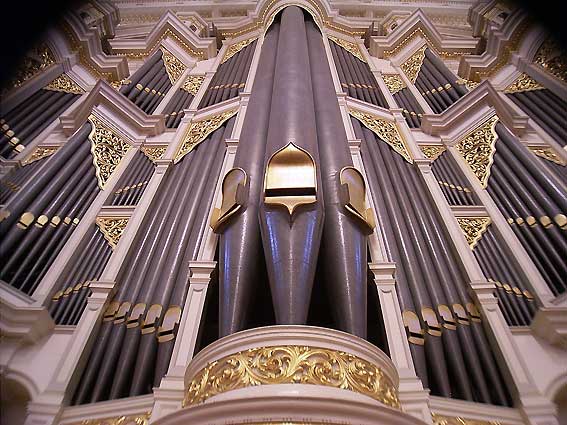
Photo taken looking up from console (MQ)
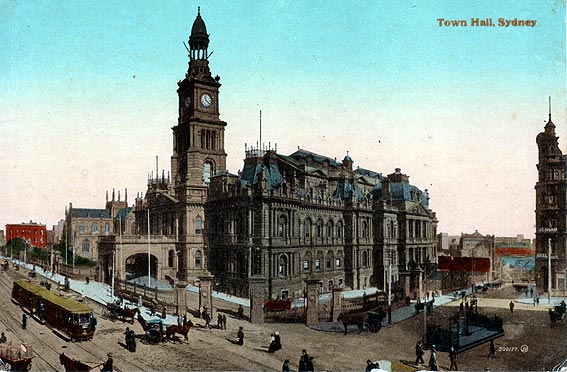
From a postcard c. the turn of the century
(before the construction of the underground railway)
The following images have been taken during the 2011 and continuing cleaning of the organ by Rodney Ford.
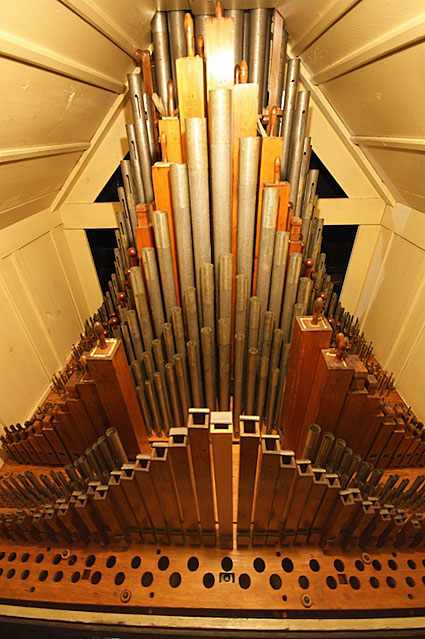
Echo fluework during cleaning, the Bassett Horn is yet to be reinstalled.
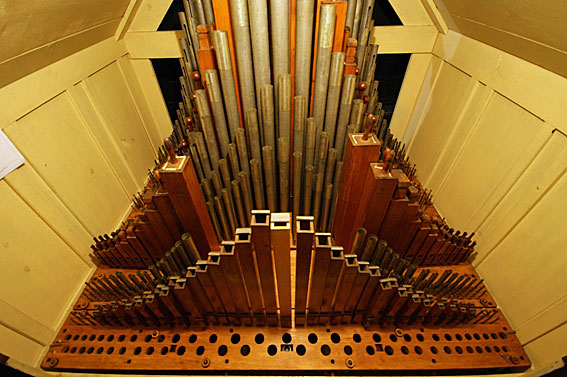
Another view of the Echo division.
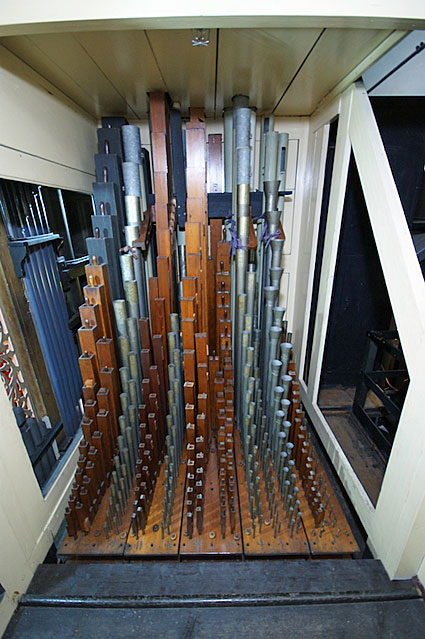
Solo fluework, C side following cleaning work.
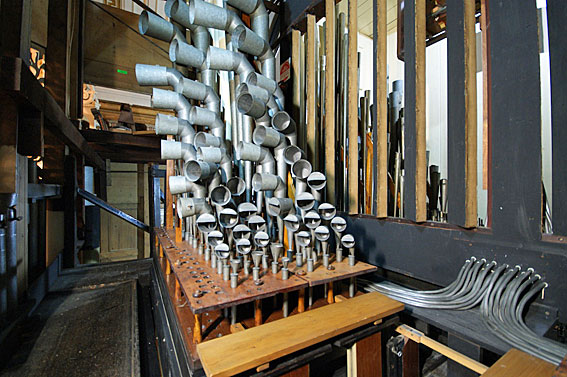
Solo Tubas, C side, during installation following cleaning. The Tuba Clarion 4 yet to be reinstalled.
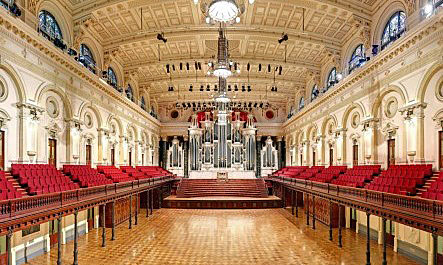
[1] Visitor’s Guide to Sydney Town Hall. Sydney: Sydney City Council, c.1995.
[2] A complete history of the construction and musical use of the Town Hall organ was written in 1999 by OHTA Patron, Robert Ampt, who has been City Organist since 1977. The volume comprises 208 pages and is copiously illustrated, including numerous colour plates. (Robert Ampt, The Sydney Town Hall Organ: William Hill and Son’s Magnum Opus [Woodford, NSW: Birralee Publishing, 1999]. The specification also originates from this source).
[3] See for example: George A. Audsley, The Art of Organ Building (New York: Dover Publications, 1965, reprint of Dodd, Mead and Co. edition of 1905), 723-24.
[4]
Ampt, 180.